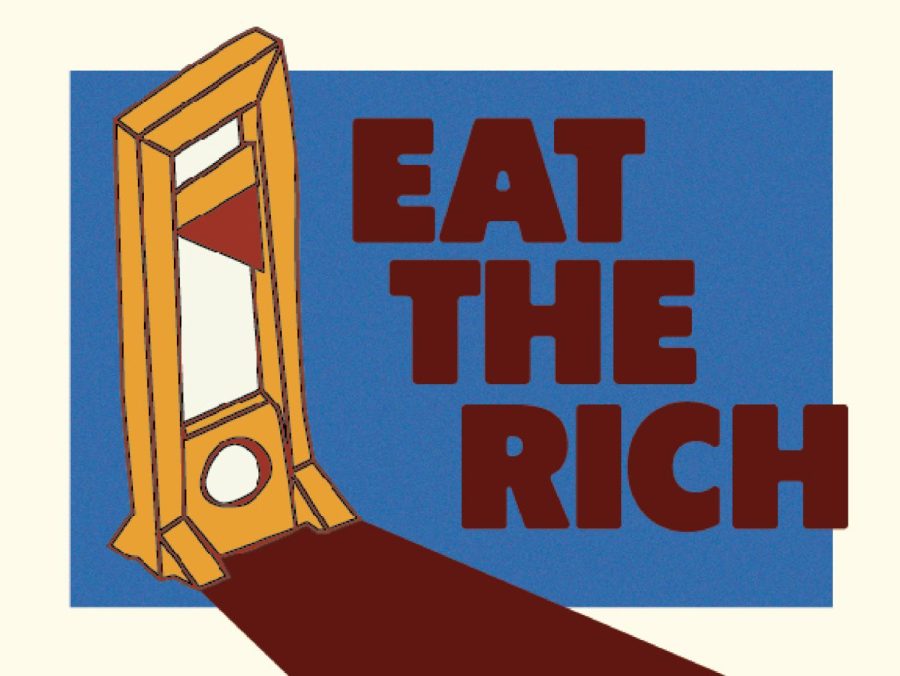Hargis: Movies About Food are Actually About Money
(Design by Mary Allen | The Daily Utah Chronicle)
June 3, 2023
While I’m not a huge fan of his, I distinctly remember watching the music video for Justin Bieber’s song “Yummy.” It was an evening in 2020, and I had nothing better to do than to click through what was trending on YouTube. The song itself is fine, so when the lights came on and the music video started, I had no idea what to expect. It certainly wasn’t the weirdly haunting video I got instead.
While Bieber lip-syncs to the track, he sits around a round table with finely-dressed people, most of whom are decades older than him. The video depicts those at the table enjoying mounds of Jell-O, huge slices of white cake and candy peanuts. The concept of the video is campy and strange, an attempted joke about the well-to-do people who are eating processed food. How silly is it that a group of rich and luxurious people would stoop so low as to eat pre-made food?
I touch on this because there are a few movies that contained the same focus on consumption that are just as campy, and even eerier than Bieber’s confusing video. Both “The Menu” and “Hunger” caught my attention as films about cooking and eating, but also contain underlying themes about both the people who do the cooking and the people who do the eating. And in each movie, the sentiment is the same — the people who do the cooking are angry, and the people who do the eating are not only partially to blame but will also become their victims.
The Menu
When “The Menu” first hit theaters, I was almost certain it would be a bad film. It looked like an obvious cash grab, using big names like Anya Taylor-Joy and Ralph Fiennes to wax poetic about the uber-wealthy. And while the film did just that, I found myself enjoying it.
The film follows Taylor-Joy’s character, Margot — a sex worker from the Midwest — as she delves into a culinary experience designed for the economic one percent. As tensions build between the highly awarded head chef, played by Fiennes, Margot builds an eerie camaraderie with him built on their shared poor upbringings. By the movie’s end, the head chef’s burning hatred for the rich peaks as he forces them into grueling, life-threatening situations, and concludes the fine-dining experience by lighting the restaurant on fire with his staff and patrons inside in a haunting murder-suicide.
After watching, the audience is meant to realize its multiple different themes — first, it makes fun of the world of fine dining. The service itself takes place on a private island, where the consumers have had to pay exorbitant sums to simply make an appearance. It’s an absurd trend and one that is called out ruthlessly in this movie.
Second, it highlights the rage that is born between the cracks of the class divide. Margot is shocked and annoyed at the attitudes of her rich counterparts — she finds them ridiculous. Finally, the head chef makes his feelings for his audience clear through violence. His consumers ultimately become his victims, just as he’d planned all along.
Hunger
Set in Bangkok, Thailand, “Hunger” follows a young, lower-class fry cook who gets recruited by an in-demand celebrity chef named Paul. The fry cook, Aoy, then delves into the heated world of luxury food, serving powerful politicians and big online influencers under Paul’s gaze.
Paul’s preferences for cooking involve big, messy meals that require the consumer to tear and chop at them. This evidently calls back to our base instincts as omnivorous animals. He seems to gain a sort of sick pleasure by making the uber-wealthy make a mess of their food, despite their poised and put-together appearances. I was struck by how the chefs seem to be almost punishing their audiences with the meals — bloody meat and greasy soups placed in precarious dishes that virtually guarantee spillage — while the wealthy audience finds immense pleasure in the service and experience of celebrity catering in general.
The film itself makes fun of upper-class consumers and their density. In one scene, the celebrity caterers make a politician and his family a “gourmet soup,” made of tap water and a packet of flavoring from a cup of instant noodles. The politician can’t tell the difference, remarking on how delicious and luxurious the soup is. There is no disparagement between what is truly fine dining and what is simply a pack of noodles from the convenience store, at least from the chef’s perspective. The consumers, on the other hand, will indulge in it all the same.
Throughout the movie, you are forced to compare the humble lifestyle of Aoy with the gluttonous ways of her rich audience. While she scrambles to be a good enough cook, she also battles with the question — how much should you sacrifice to only become wealth-adjacent?
The Rich Eating and Eating the Rich
Both of these films grapple with class inequality through culinary arts — the rich and indulgent are the ones who eat, while the poor are the ones who serve. Yet while the lower class feeds the upper class, an underlying theme of anger and punishment ruminates. It leads the cooks to do immoral things to their audiences, whether it be feeding them absurd meals for large amounts of money or causing them literal bodily harm. I mean, “The Menu” ends in mass murder.
Whether these movies are meant to spur action in the audience, like organizing against the upper class to seek the revenge that is wrought in these movies, or to be cathartic to audiences who may be middle to lower class, is up for debate. But I’m almost certain that we’ll be seeing more of these movies in the future as the recession progresses.









